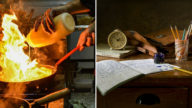Introduction
Jan Morris, one of Mike’s favorite travel writers, captured a sentiment about Madrid:
The height of human happiness, infatuated Madrileños like to say, must be to go to that part of heaven from which there is a view of Madrid.
Jan Morris, “Spain“*
When we were in Madrid recently, we only got a glimpse of the city, but we can understand the feeling. We spent three days exploring the historic center Spain’s capital. Here are a few of the things we saw and experienced.
Getting there
We flew from Lisbon mid-day on a Tuesday and arrived in Madrid’s massive airport. There are three interconnected terminals that stretch for what seem like miles and a fourth, newer, terminal that is physically a mile or more away. We caught a bus to go from one of the older terminals to the new one so we could buy metro tickets for Madrid and train tickets for our later trip to Valencia. Then we rode the metro and a regional train to a stop near our hotel.
A room with a view
Mike had booked us into the Hotel Europa, a stately older hotel adjacent to the Puerta del Sol, a large plaza in the center of Madrid’s historic district. The thing that appealed to him was that he could reserve a room that overlooked the plaza. But when we arrived we found that there was major construction going on in the plaza. It was all torn up, with most of it fenced off.
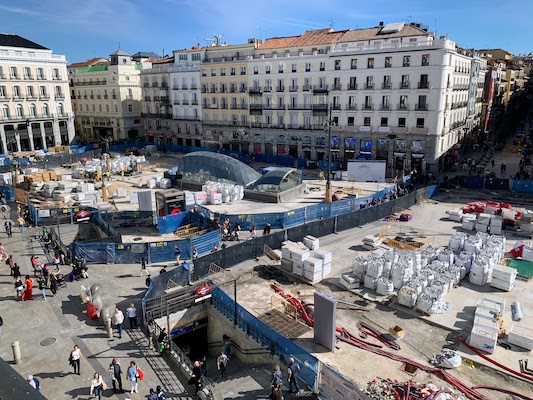
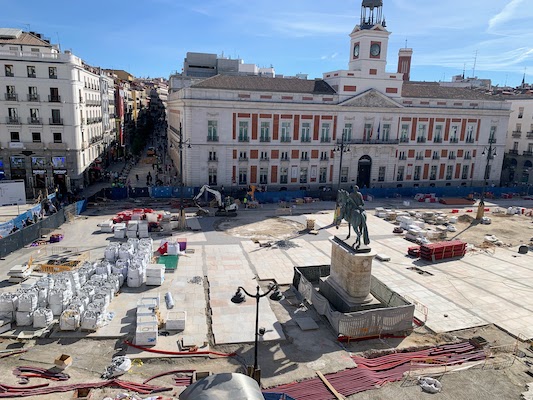
We probably paid a little bit extra to get this view.
In the center of the Puerta del Sol is a statue of King Charles III of Spain on horseback. During his reign In the 18th century, Charles initiated many improvements in Madrid, including adding numerous fountains, establishing public schools, creating underground sewers, and building the Prado museum. For all his efforts he earned the nickname “the best mayor of Madrid”. We thought it was appropriate that today he is surrounded by more improvement work.
In the center of the action
Even with the construction, the Puerta del Sol was busy all day and all night. There was an endless stream of people moving through the plaza. When we were down at street level it seemed more crowded because everyone was channeled through narrow corridors around and across the plaza.
On our first night, we stood on the small balcony outside our room and watched the crowds move through the plaza after 11pm. We left the shutters and the window open to hear the voices, laughter, and singing from the street below.
What struck us was that all the sounds were happy. There was no fear being expressed, no one was feeling threatened. These were people who were moving freely to do what they wanted to do.
On two of our three evenings at the hotel, people stood on a platform below our window and gave long, loud, and energetic speeches. We couldn’t tell what they were agitating for, but guessed it was either a political party or an environmental cause. Their fervor was evident, but they didn’t draw much of a crowd.
Mary meets the bear
At the eastern end of the Puerta del Sol is another statue – El Oso y el Madroño, usually translated as “the bear and the strawberry tree.

It is the official symbol of Madrid, but the origins of the symbol are unclear. There used to be bears living in the fields around Madrid, and there were many madroño or hackberry trees which bore fruit that looked like strawberries. (The madroño berries are used to make a traditional liqueur.)
Regardless of its origins, the symbol is beloved by the people of Madrid and the statue is a popular spot for photographs. And even with the construction barriers, Mary was able to get her photo taken.
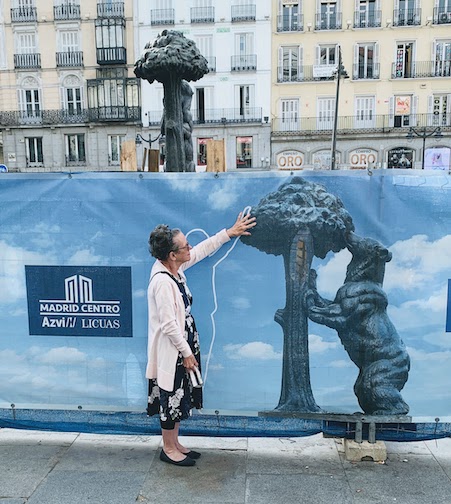
The Plaza Mayor
Less than half a kilometer from the Puerta del Sol is the Plaza Mayor, a rectangular plaza surrounded by four story buildings. In 1619, King Philip III (that’s him on horseback) made Plaza Mayor the original center of Madrid.
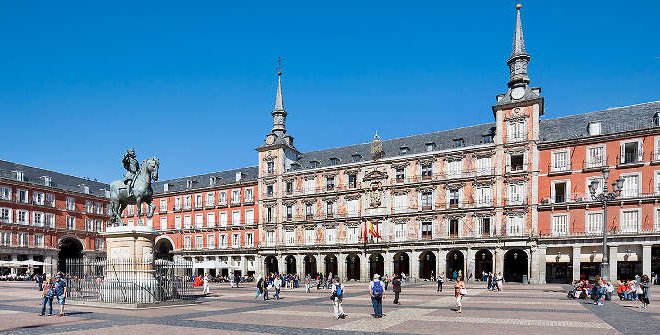
Over the centuries since, the plaza has been the scene of all sorts of activities, including bullfights and Carnevale celebrations. During the Spanish Inquisition (1478 – 1834), persons convicted of heresy were paraded around the square before being executed in front of audiences sitting on bleachers built for the occasion.
Nothing quite so terrifying was happening on the days we walked through the Plaza. It was always busy. Around the perimeter, people were enjoying snacks and drinks at cafe tables shaded by large umbrellas.
Tour groups huddled in small clusters, before being herded off by their flag-waving guides. And there were the African vendors, young men with purses, sunglasses or other trinkets spread out on sheets. Most had strings tied to each corner of the sheets so that they could quickly pick up and leave.
Under the arches of the buildings, were small shops. We enjoyed wandering the perimeter and peeking into the shops. There was even one that sold nothing but rubber ducks.
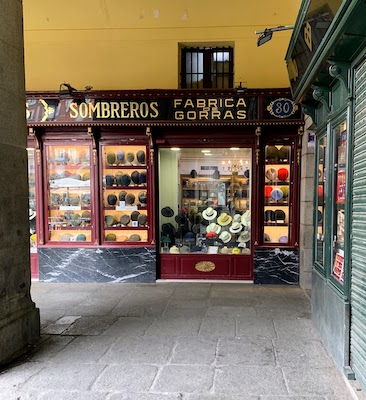
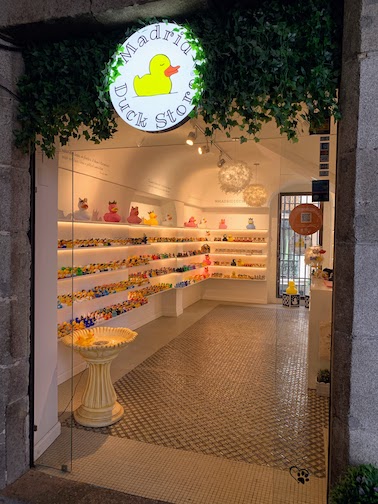
Archways at various points around the plaza gave a glimpse of interesting streets that beckoned us to explore them.
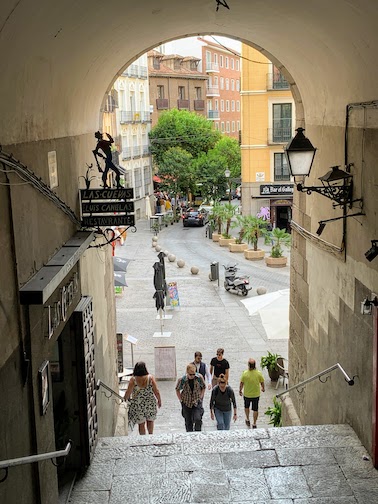
A quick lunch
Outside one of the arches we found Casa Rua, a small hole-in-wall restaurant that specialized in bocadillas de calamares – calamari sandwiches.
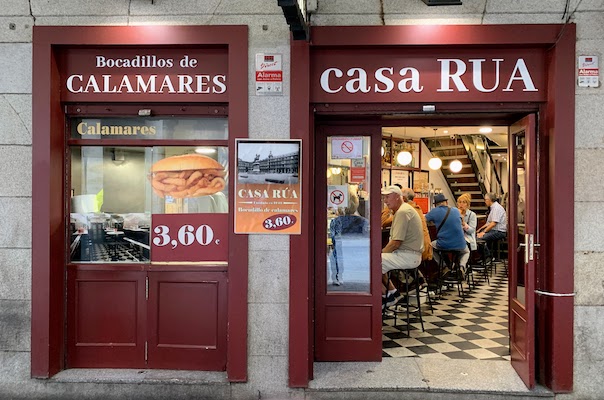
Each sandwich was a big pile of fried calamari on a soft white bun. The squid was hot – cooked to order and served right out of the fryer. It was crispy and salty on the outside. The flesh was slightly sweet inside.
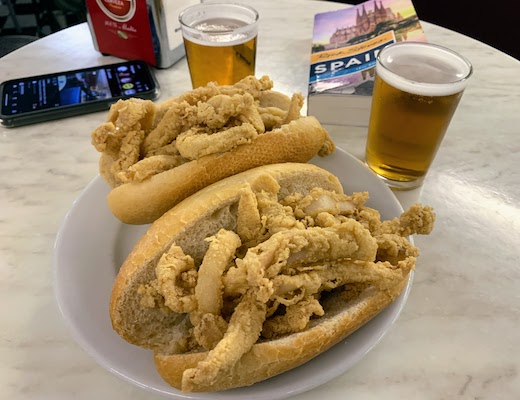
Our lunch – 2 bocadillas and 3 cañas – small glasses of draft beer – was €12. We figured it was one of the best bargains we would find in Madrid.
The Mercado de San Miguel
In an earlier post, we admitted that we travel to eat. With that kind of focus, the Mercado de San Miguel is the kind of place we’re going to gravitate to. The Mercado is the oldest surviving market hall in Madrid.
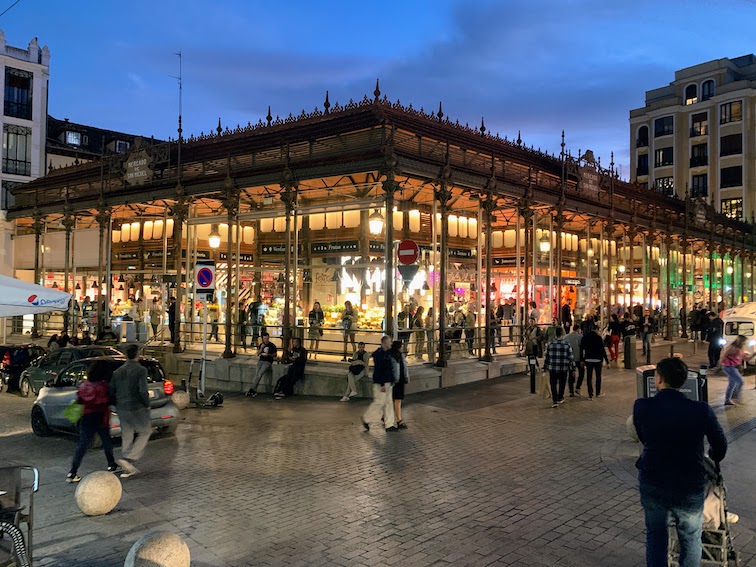
The ornate iron and glass structure was originally built in 1916. It later fell into disrepair and was all but abandoned. A consortium of private investors purchased the building in 2003, renovated it, and reopened it as a gourmet market in 2009.
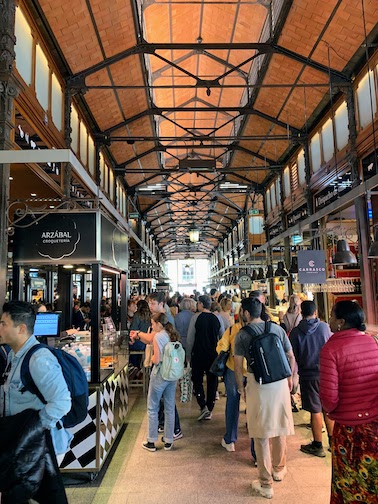
There are over 30 vendors in the mercado, selling everything from freshly prepared tapas, olives, cheeses, hams, fish, bread, pastries and baked goods. You can buy a glass of wine, beer, or vermut to enjoy along with your food.
We visited the Mercado several times. It was busy whenever we were there.
Here are some of the tempting treats we saw in the Mercado.
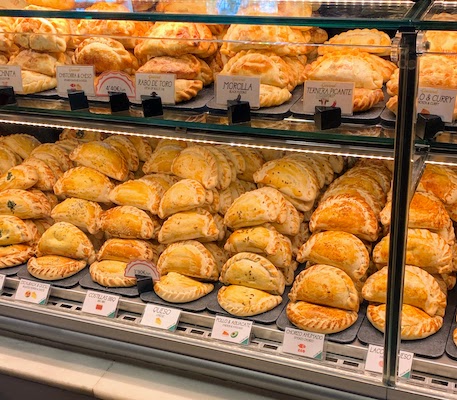
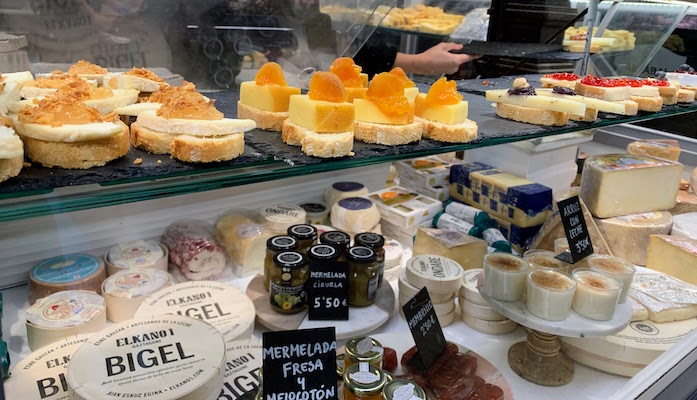
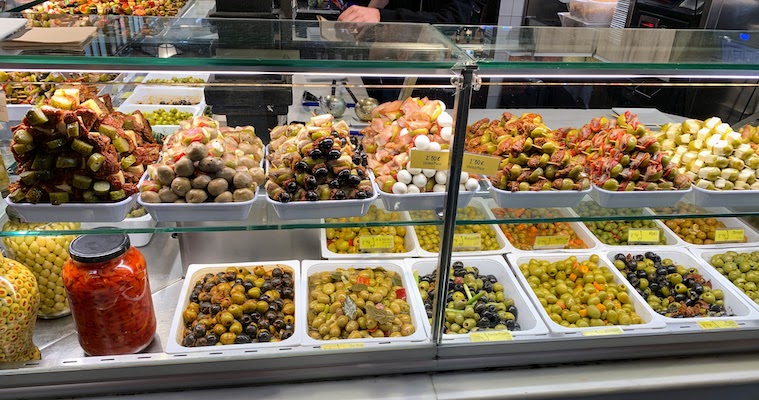
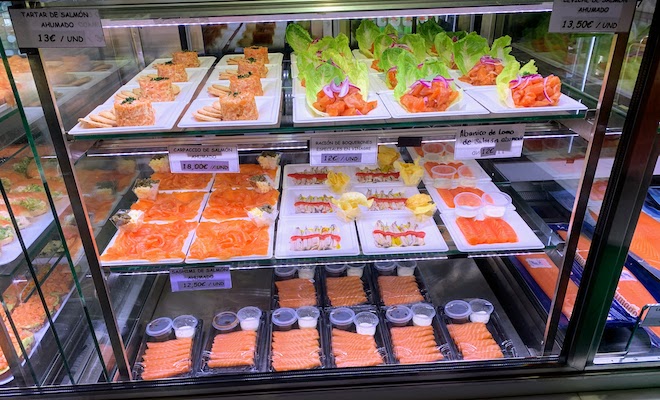
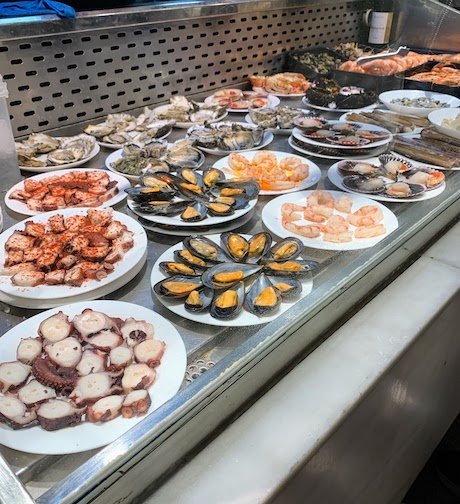
Mike said if he lived in Madrid, he would be at the Mercado every week.
Separating church and state
A few blocks from the Mercado are two imposing buildings that face each other across a plaza. The Catedral de la Almudena (Almudena Cathedral) was designed to look like it was built in the 13th century, but it is actually a new structure. Construction began in 1882, was halted during the Spanish Civil War ( 1936 – 1939), and the building was completed and consecrated in 1993.
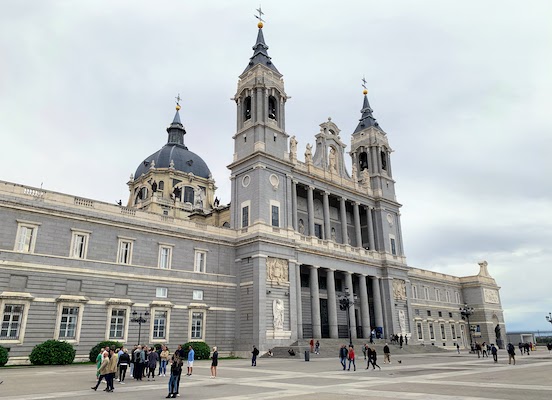
The Almudena Cathedral
The Cathedral faces north towards the Plaza de la Armería. On the opposite side of the plaza is the Palacio Real de Madrid, the Royal Palace of Madrid.
The Royal Palace
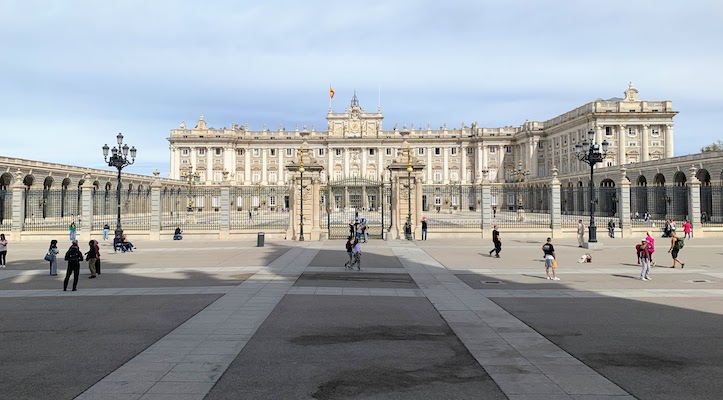
The two buildings stand in dynamic tension to one another. The overall impression is that they represent competing interests. While we were waiting to enter the palace, the bells of the cathedral rang. Their loud chimes diverted the attention of everyone standing in line.
Touring the Palace
The Royal Palace is the largest in Western Europe, and one of the largest in the world. It has over 3,400 rooms and encompasses 135,000 square meters – that’s almost 1 ½ million square feet! Construction of the Palace was begun by King Philip V in 1738. Philip was born in France and wanted to create a palace to rival Versailles. His son, King Charles III, who was also the King of Naples, the King of Sicily, and as noted above, the best mayor of Madrid, brought in famous Italian painters to decorate the palace. Later kings expanded the palace and added more decoration – each trying to outdo the last with more grandiose ornamentation.
We took a self-guided tour of the palace and were nearly overwhelmed by the decor. Photographs were not permitted inside the palace, though many visitors continued to take them, even after being yelled at by the docents.
These two photos, from the official palace website give you a tiny glimpse of what the interior is like.
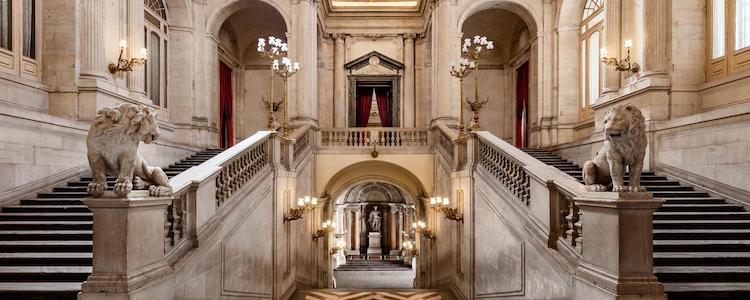
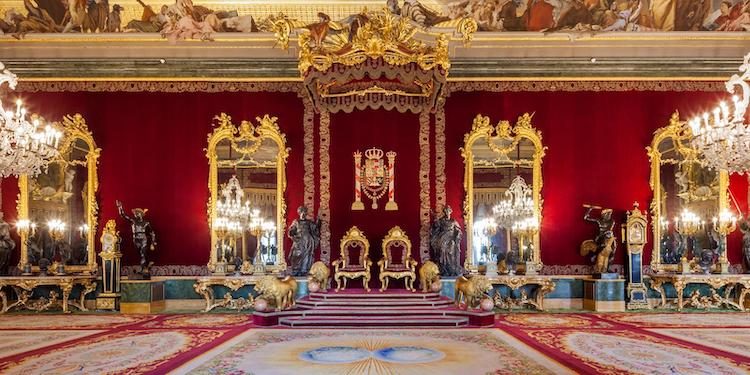
Our recommendation: If you’re in Madrid, make time to tour the palace. Our tickets were €13.20 each (including the audio guides) and can be purchased online. There is a separate entry line for ticket holders. The audio guides were small tablets that provided narration for the various rooms along with photographs of specific features – most of which were roped off from visitors.
Moving On
On our last afternoon in Madrid, we went to the Museo Nacional Centro de Arte Reina Sofía , a national museum dedicated to modern art. The next day we took the high-speed train to Valencia. We’ll tell you more about those in future posts.
We thoroughly enjoyed our visit to Madrid and look forward to returning someday. On this trip we were never more than about 1 kilometer from the Puerta del Sol, so there is so much more of the city to see.
What new city have you ticked off your bucket list lately? Put a pin on the map with a comment below or a note via the Contact Us form.
Until next week / Até a próxima semana
Mary and Mike
The Cook and The Writer
* This link is direct to Amazon.com, but we do not receive any affiliate payment if you buy a copy. If that changes in the future, we’ll let you know. [Updated May, 2024]
